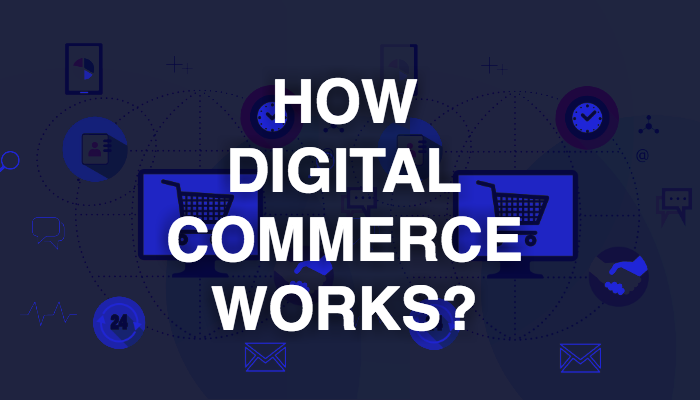
No one is accurately aware of when mankind started trading! From horses to ships, from trucks to airplanes, the need to trade goods has shaped some of the best innovations for mankind. With more and more ideas shaping up the business arena, digital commerce is one trend that is slowly concurring the enterprise world. So, what is digital commerce or digital commerce? Put in simple words “Digital commerce involves buying and selling of goods and services by the use of internet, mobile networks and other commerce infrastructure.”
However, there is more to this. Digital commerce includes the entire range of marketing activities to support these transactions. This includes people, processes and technologies to execute the necessities of developing content, analytics, promotion, pricing, customer acquisition and retention, and customer experience throughout the entire business journey.
What differentiates digital commerce from the traditional ways of trade is that it allows you to just sit in your armchair, click the mouse a few times, enter your credit card number, and wait for the goods to be delivered at your doorstep. Since the last one decade, digital commerce, has made the customer’s life more convenient and has opened up all kinds of new opportunities for businesses.
Basic components of a digital commerce system
Digital commerce is all about combining three different components of a web server, a database system and a dispatch system. The web server manages the online storefront and process transactions while the database system helps to keep a check of the items the store has in stock. The dispatch system linked to the warehouse makes sure to locate the goods instantly and send to the customer as soon as possible.
How to build and design a digital commerce website?
It is interesting to note that the success or failure of most online businesses is dependent on the build and design of these virtual stores. This doesn’t necessarily indicate that the digital commerce web sites have to look attractive. But, it is important that they have to be usable in terms of quick and easy navigation, reliable in terms of round-the-clock availability and secure in the terms of protection from online frauds.
Setting up an online store has become much easier these days as compared to the early decades, thanks to technology! Many third-party websites help in building stores in a matter of few clicks as an independent entity or as mini versions under their huge websites.
Choosing a right domain name is essential to draw people’s attention. Managing how to get your products to your customers is critically important too. While setting up and designing your digital commerce store, it is important that you keep certain things in mind.
- Draw attention to related products
- List out the product details clearly
- Simplify the checkout process for the customers
- Keep an effective and simple call to action for your website
- Keep ample number of photos, specification related to your product/services
- Keep more granular search, filtering options and easier navigation
- Choose a digital commerce platform that best suits your needs
Let us look at a simple example of the mechanism that digital commerce follows. Not every digital commerce transaction happens this way, though.
- At the comfort of her home, a customer tries to order a DVD online. The first thing that happens is that the web browser communicates back-and-forth with a web server that manages the store's website.
- It queries a database to find out whether the customer’s product is in stock.
- Then, the web server sends her order to the order manager. This is nothing but a central computer that sees orders through every stage of processing, right from the submission to dispatch.
- In case that the item is out of stock, the stock database system orders new supplies from the wholesalers or manufacturers. This could require further communication with order systems at the manufacturer's headquarters to find out estimated time to supply the product.
- The stock database then suggests an estimated delivery date when supplies will be received from the manufacturer.
- The order manager then communicates with a merchant system (run by a credit-card processing firm or linked to a bank) to charge payment using the customer's credit or debit card number.
- The merchant system might involve in a few extra checks with the customer's own bank computer.
- The bank computer confirms whether the customer has enough funds in their bank accounts for the transaction.
- The merchant system authorizes the transaction, though funds will not be completely transferred until several days later.
- The order manager confirms the successful processing of the order and sends a notification to the web server.
- The web server displays a confirmation page to the customer stating that her order has been processed.
- The order manager sends a request to the warehouse to dispatch the goods to the customer.
- Goods are then collected from the warehouse.
- After the dispatch, the warehouse computer sends a mail to the customer confirming the same.
- The goods are then delivered to the customer.
Digital commerce works in a similar fashion as physical retail. However, the fact that it operates digitally, introduces some unique business elements for the businesses to understand and implement.
Here is how digital commerce works:
Mechanism to sell products/services
This step is the heart of commerce, both physical and digital. There has to be an exchange of value. Today, almost all goods that sell in physical stores are also available for sale on digital commerce websites. Digital commerce has also encouraged the easy sale of new categories of products like e-books, software, apps and the like. Besides these, digital commerce enables easy transactions in a wide variety of goods such as air tickets and magazine subscriptions.
Mechanism to accept orders
Once the customer has decided to trade with your digital commerce business, there has to be a process that accepts their order. Here arises the need to have a software that runs this process: the shopping cart. This software makes a note of the purchases and updates the order database, while computing the taxes and other levies, processing coupons, capturing the billing and delivery addresses etc. In case of downloadable digital goods, the shopping cart redirects the customers to the download page, once they have made the payment.
Payment mechanism
Digital commerce websites, particularly in the B2B space provide credit for purchases. In regular cases, a digital commerce transaction involves transacting money which is carried out by a software known as the payment gateway.
The payment gateway is responsible for providing the customers with the payment options, including their identification and authentication details like credit card numbers, CVV code etc.
Delivery
Effective and capable logistics is the key to a successful digital commerce business. Online purchase often faces the criticism of indeterminate and inordinate delay in the delivery of goods.
Therefore, it is important for digital commerce businesses to make sure that the right product is delivered to the right customer, in good condition, and in the stipulated time period. Most businesses today outsource the delivery to third-party logistics partners.
Customer service
Businesses are primarily run by customers. If you do not have customers, who would you sell to? Therefore, it is mandatory to keep the customers happy and also provide pre-sales as well as post-sales services to them.
Reverse logistics
It is important to arrange for reverse logistics to cater to the needs wherein a customer might want to return or exchange the goods/services that have been delivered. This shows that you are caring towards your customer’s satisfaction.
Advantages and Disadvantages of digital commerce
In the early days of its inception, reactions to digital commerce websites were often mixed. The customers were often apprehensive about the quality and security of the services and products. However, things have improved over a few years now and online businesses have found solutions to a variety of drawbacks that existed. A vast majority of customers worldwide now rely on digital commerce and prefer that over a real-world store where prices are often higher, waiting lines are longer, and the doors open only during normal business hours.
Speaking about businesses and entrepreneurs, digital commerce has opened up all kinds of new opportunities. Digital commerce has made it possible for aspiring businesses to open an online store and start trading within a matter of minutes. Small local stores who used to face competition from business giants have found a new lease of life by taking their business online and selling their products through the internet.
However, today digital commerce has posed a threat to many traditional ways of doing business. With more and more people resorting to online modes of transactions, the real-world stores are hit. The business giants have started implementing the concept of "bricks and clicks" (having real world stores and a seamlessly integrated website) which has been widely accepted by customers.
Let us, now, look at the advantages and disadvantages of digital commerce in a crisp.
Advantages:
- Easy browsing of products
- Faster buying/selling process
- Buying/selling 24/7
- Greater reach to customers cutting across geographical limitations
- Lesser operational costs
- Better quality of services
- No need of physical infrastructure or set-ups
- Customers can easily select products from different providers without moving around physically
- Despite the huge popularity, digital commerce doesn’t guarantee the quality of products
- Mechanical failures cause unpredictable effects on the total process of digital commerce
- Customer loyalty is always on a check because there is minimum chance of direct customer to company interactions
- Digital commerce sites, services, payment gateways, all are always prone to cyber frauds and attacks
- Thorough expertise is needed for digital commerce infrastructure
- Need for an expanded reverse logistics system
- Although digital commerce accounts for only a small fraction of the total trade, it is important to know that the fraction has been growing steadily and looks promising to continue doing so.
With the growing and changing technology, more and more people these days go online through their cell phones and other hand-held electronic devices. This has led to the emergence of mobile commerce or m-Commerce. The goalposts have changed: clicking the mouse is being increasingly replaced with poking at the touchscreen tablets.
Switching over to m-Commerce is inevitable as Google has repeatedly highlighted the importance of running a mobile-friendly site. Gartner forecasts that mobile commerce will represent about half of all ecommerce (digital commerce revenue) by 2017.
What to do in order to go mobile?
Before planning to go on the mobile platform, you need to check out how well your existing site works on a mobile in terms of the speed and usability. You could also use emulators and testers to simulate mobile devices on a PC although it is highly advisable to use a modern cellphone with a browser or a tablet computer and see how your website works for real. However, if your site has been designed to work for a typical widescreen system only, you'll probably find that your website looks terrible on the small screen of a cellphone: columns probably wrap and overlap, the text may be too small to read etc. However, these can be corrected. Let us look at a few options to consider if you want to go mobile.
Responsive design:
Redesigning your existing site so that the same HTML code would work equally well on both desktop and mobile. This could be achieved by using a common stylesheet having conditional rules that apply to devices of different screen width. Responsive sites are easy to maintain and search-engine friendly. However, they do not provide the best of user experience as they present the same pages in different formats.
Dynamic serving:
You could also consider building your pages differently for desktop and mobile devices without changing their URLs. Specifically, you would need to use PHP or ASP to test for a mobile device and then build a desktop or mobile optimized page, perhaps using a desktop or mobile stylesheet that reformats your common HTML code accordingly. Dynamic serving is search-engine friendly and is good on user-experience also.
Separate mobile site:
By researching on the percentage of users that use a handheld device compared to PCs, you could consider redirecting to a completely separate mobile version of your site. This way you can optimize your site for mobile users without having to compromise on the usability for PC users. But the difficulty lies in maintaining a second version of your site. Also, it is important to remember that search engines such as Google disapprove of duplicate content. You could use techniques like canonical URLs to help them understand where to find the definitive version of each page.
Separate mobile app:
Another technological development that is winning hearts these days are the mobile apps. You could develop a free app for mobile devices that would effectively allow users to skip your website altogether. There's an expense involved in developing apps, but they generally give a much better user experience than mobile websites. They also prevent users from getting distracted, clicking other links, and going off to competitor sites. Put in simpler words, mobile apps work greatly, both in customer acquisition and retention.
Conclusion
To be successful in the digital commerce industry, it is important to manage each of its moving parts skillfully. One needs to be ready with a set of best practices and standards to manage the challenges of digital commerce and drive growth. Proper timing and a focused digital commerce strategy can be a game changer for most businesses, and can become the harbinger for multichannel revenue expansion powered by compelling content and insights.




.jpg)





